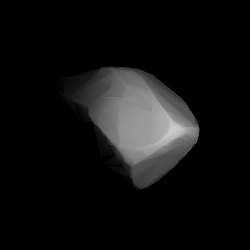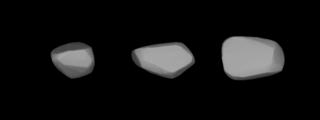Christian Pollas is a French astronomer, known for the discovery and observation of minor planets and supernovae.
Lutz Dieter Schmadel was a German astronomer and a prolific discoverer of asteroids, who worked at the Astronomisches Rechen-Institut (ARI) of the University of Heidelberg.

Endymion is a large Main belt asteroid. It was discovered by Max Wolf on 17 October 1892 in Heidelberg. It was the first asteroid to receive the name of a male god.

2002 Euler is a stony background asteroid from the inner regions of the asteroid belt, approximately 17 kilometers (11 miles) in diameter. It was discovered on 29 August 1973, by Russian astronomer Tamara Smirnova at the Crimean Astrophysical Observatory in Nauchnyj, and assigned the prov. designation 1973 QQ1. It was named after Swiss mathematician Leonhard Euler.
1034 Mozartia, provisional designation 1924 SS, is a stony asteroid from the inner regions of the asteroid belt, approximately 8 kilometers in diameter. It was discovered on 7 September 1924, by Soviet Vladimir Albitsky at Simeiz Observatory on the Crimean peninsula, and named after Wolfgang Amadeus Mozart.

1905 Ambartsumian, provisional designation 1972 JZ, is an asteroid from the inner regions of the asteroid belt, approximately 8 kilometers in diameter. It was discovered on 14 May 1972, by Russian astronomer Tamara Smirnova at the Crimean Astrophysical Observatory, Nauchnyj, on the Crimean peninsula. The asteroid was named after theoretical astrophysicist Victor Ambartsumian.
1713 Bancilhon, provisional designation 1951 SC, is an asteroid from the inner regions of the asteroid belt, approximately 5.7 kilometers in diameter.
1818 Brahms, provisional designation 1939 PE, is an asteroid from the inner regions of the asteroid belt, approximately 6 kilometers in diameter. It was discovered on 15 August 1939, by German astronomer Karl Reinmuth at Heidelberg Observatory in southern Germany. The asteroid was named after composer Johannes Brahms.
2134 Dennispalm, provisional designation 1976 YB is a main-belt asteroid discovered on December 24, 1976, by Charles T. Kowal at Palomar Observatory.
2080 Jihlava, provisional designation 1976 DG, is a stony Flora asteroid from the inner regions of the asteroid belt, approximately 6 kilometers in diameter. The asteroid was discovered on 27 February 1976, by Swiss astronomer Paul Wild at Zimmerwald Observatory near Bern, Switzerland. It was named after the Czech city of Jihlava.

1682 Karel, provisional designation 1949 PH, is a stony Florian asteroid from the inner regions of the asteroid belt, approximately 7.5 kilometers in diameter.
1755 Lorbach, provisional designation 1936 VD, is a stony Eoan asteroid from the outer region of the asteroid belt, approximately 25 kilometers in diameter.

1637 Swings, provisional designation 1936 QO, is a dark asteroid from the outer region of the asteroid belt, approximately 50 kilometers in diameter. Discovered by Joseph Hunaerts in 1936, it was named after Belgian astronomer Pol Swings.
1944 Günter, provisional designation 1925 RA, is an asteroid from the inner regions of the asteroid belt, approximately 5 kilometers in diameter.
1856 Růžena, provisional designation 1969 TW1, is a stony asteroid from the inner regions of the asteroid belt, approximately 6.6 kilometers in diameter. It was discovered on 8 October 1969, by Russian astronomer Lyudmila Chernykh at Crimean Astrophysical Observatory in Nauchny, on the Crimean peninsula. The asteroid was named after Růžena Petrovicova, staff member at Kleť Observatory.
Paul Herget was an American astronomer and director of the Cincinnati Observatory, who established the Minor Planet Center after World War II.
This page is based on this
Wikipedia article Text is available under the
CC BY-SA 4.0 license; additional terms may apply.
Images, videos and audio are available under their respective licenses.




